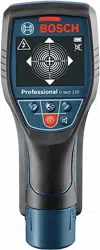Loading ...
Loading ...
Loading ...

-4-
C
12
13
11
General Safety Rules
Working safely with the measuring tool is possible only when the operating and
safety information are read completely and the instructions contained therein are
strictly followed.
Read all instructions. Failure to follow all instructions listed below may result in
electric shock, fire and/or serious injury.
SAVE THESE INSTRUCTIONS
The detector’s ability to detect objects is affected by the proximity of other
equipment that produce strong magnetic or electromagnetic fields, and by
moisture, metallic building materials, foil-laminated insulation materials and/or conductive wallpaper.
The detector’s ability to detect wood substructures (studs) is also affected by
inconsistency on the thickness of the surface material, such as plaster and lath.
It is possible that there may be metal, wood or wiring or something else, such as
plastic pipes, beneath the scanned surface that is not detected.
The detector alone should not be relied on exclusively to locate items below
the scanned surface. Use other information sources to help locate items before
penetrating the surface. Such additional sources include construction plans, visible points of entry
of pipes and wiring into walls, such as in a basement, and standard 16” and 24” stud spacing
practices.
Before penetrating a surface (such as with a drill, router, saw or nail), always shut
off the electrical power, gas and water supplies. Cutting, drilling, etc… into these
items when operational can result in personal injury.
For technological reasons, the measuring tool cannot ensure 100 % certainty. To
rule out hazards, safeguard yourself each time before drilling, sawing or routing in
walls, ceilings or floors by means of other information sources, such as building plans, pictures from
the construction phase, etc. Environmental influences, such as humidity or closeness to electrical
devices, can influence the accuracy of the measuring tool. Surface quality and condition of the walls
(e. g., moisture, metallic building materials, conductive wallpaper, insulation materials, tiles) as well
as the amount, type, size and position of the objects can lead to faulty measuring results.
!
WARNING
!
WARNING
!
WARNING
!
WARNING
!
WARNING
!
WARNING
!
WARNING
!
WARNING
Loading ...
Loading ...
Loading ...
